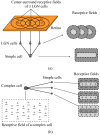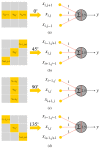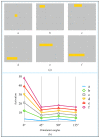Artificial Visual System for Orientation Detection Based on Hubel-Wiesel Model
- PMID: 35448001
- PMCID: PMC9025109
- DOI: 10.3390/brainsci12040470
Artificial Visual System for Orientation Detection Based on Hubel-Wiesel Model
Abstract
The Hubel-Wiesel (HW) model is a classical neurobiological model for explaining the orientation selectivity of cortical cells. However, the HW model still has not been fully proved physiologically, and there are few concise but efficient systems to quantify and simulate the HW model and can be used for object orientation detection applications. To realize a straightforward and efficient quantitive method and validate the HW model's reasonability and practicality, we use McCulloch-Pitts (MP) neuron model to simulate simple cells and complex cells and implement an artificial visual system (AVS) for two-dimensional object orientation detection. First, we realize four types of simple cells that are only responsible for detecting a specific orientation angle locally. Complex cells are realized with the sum function. Every local orientation information of an object is collected by simple cells and subsequently converged to the corresponding same type complex cells for computing global activation degree. Finally, the global orientation is obtained according to the activation degree of each type of complex cell. Based on this scheme, an AVS for global orientation detection is constructed. We conducted computer simulations to prove the feasibility and effectiveness of our scheme and the AVS. Computer simulations show that the mechanism-based AVS can make accurate orientation discrimination and shows striking biological similarities with the natural visual system, which indirectly proves the rationality of the Hubel-Wiesel model. Furthermore, compared with traditional CNN, we find that our AVS beats CNN on orientation detection tasks in identification accuracy, noise resistance, computation and learning cost, hardware implementation, and reasonability.
Keywords: artificial visual system; hubel–wiesel model; orientation selectivity.
Conflict of interest statement
The authors declare no conflict of interest.
Figures






















References
-
- Fiske S.T., Taylor S.E. Social Cognition. 2nd ed. McGraw-Hill Education; New York, NY, USA: 1991.
-
- Medina J. Brain Rules: 12 Principles for Surviving and Thriving at Work, Home, and School. Pear Press; Seattle, WA, USA: 2009.
Grants and funding
LinkOut - more resources
Full Text Sources

